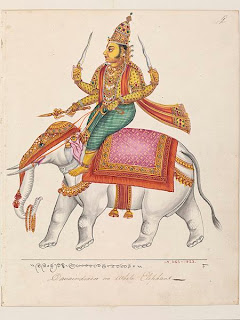By Alli Sinclair
Alli is taking a short break this week so we're running her post from November last year about the Incan gods and their relationship with the weather.
Travelling
through the lands where the Incas once lived, it’s hard not to marvel
at their craftsmanship when it came to building fortresses and cities
out of large blocks of stone. But what has intrigued me most about the
Incas is the wonderful myths, legends, and beliefs that powered this
captivating civilization.
My last book, Vestige,
had a lot of Incan theology in it, and every time I did research, I
would come across conflicting versions of gods, descriptions of their
appearances, and purpose. Rarely were two descriptions ever the same,
and this is to do with the Incas adapting their religion as their world
expanded. Once the Spanish arrived, the Incas’ belief that they were the
only people in existence had to change, and as a result, their beliefs
were challenged.
The Triad Gods were among the Incas’ most revered and they were worshipped at places like Qoricancha,
Cuzco’s main temple. These multi faceted celestial beings had
overlapping powers, and even though they were worshipped at the same
time, some received more attention than others.
Wiraqocha – The Creator:
Sometimes
known as Viracocha, the Incas held this god in the highest esteem. The
Incas didn’t make sacrifices or tributes to Wiraqocha, creator of all
things, as he had everything he wanted in his possession and needed
nothing from men other than their worship. Wiraqocha created the sun and
moon, and the people who populated the earth.
When
Wiraqocha appeared in human form, he had rays above his head, snakes
entwined around his arms, and puma heads projecting from his body. An
excellent example of his image is the central figure on the Gate of the
Sun at Tiwanaku, in Bolivia.
Inti – The Sun:
The
Incas held numerous ceremonies dedicated to Inti, the patron saint of
their empire, to ensure the emperor’s welfare as well as encourage
bountiful harvests. Every province had land and herds dedicated to the
Sun God, and the church had its own storehouses that kept supplies for
the priests and priestesses and also for sacrifices.
By
1532, Inti had risen in popularity and by that point, Inti beat all the
other gods combined hands down in terms of dedicated worship and
monuments. Inca rulers claimed direct genealogical links to the Creator
through the Sun, as the Creator fathered Inti, who in turn sired the
king.
Inti was represented in a golden statue, depicting a small boy sitting down. Called Punchao (day),
this effigy had solar rays projecting from his head and shoulders, ear
spools, a chest plate, and royal headband. Serpents and lions also grew
from his body. To the Incas, Punchao bridged the gap between humanity
and the sun, and when rulers died, their organs were placed in the
hollow stomach of the statue, which they then housed in the main temple
and brought out onto the patio during the day before returning indoors
at night.
Inti-llapa – The Thunder God:
This
god of thunder, lightning, rainbows, and every other meteorological
phenomena was depicted as a human man who wielded a war club in one hand
and a sling in the other. When the people heard thunder, they believed
it was Inti-llapa cracking his sling, and the lightning was a glittering
flash off his metal garments as he moved through the heavens. Lightning
bolts were the sling stones that he cast, and the Milky Way was the
heavenly river from which he drew the rainfall. His image, Chucuylla,
was kept in a temple called Pukamarka, in the Chinchaysuyu quarter of
Cuzco, which also held an image of the Creator God. When the Incas
needed rain, they prayed to Inti-llapa.
The
belief system of the Incas is wide and varied, and even though they
couldn’t see their gods in the flesh, their faith in their gods’
existence helped grow an expansive and fascinating empire across South
America.
Even
though the great Incan civilization disappeared many, many years ago,
the monuments they left behind and the writings of the Spanish
Chronicles help us to understand what they believed in. Supernatural
gods with amazing powers were the norm, and even though the Spanish
conquerors tried to convert the Incas to Catholicism, they held on to
their supernatural gods to help them through their changing world and
challenging times.












